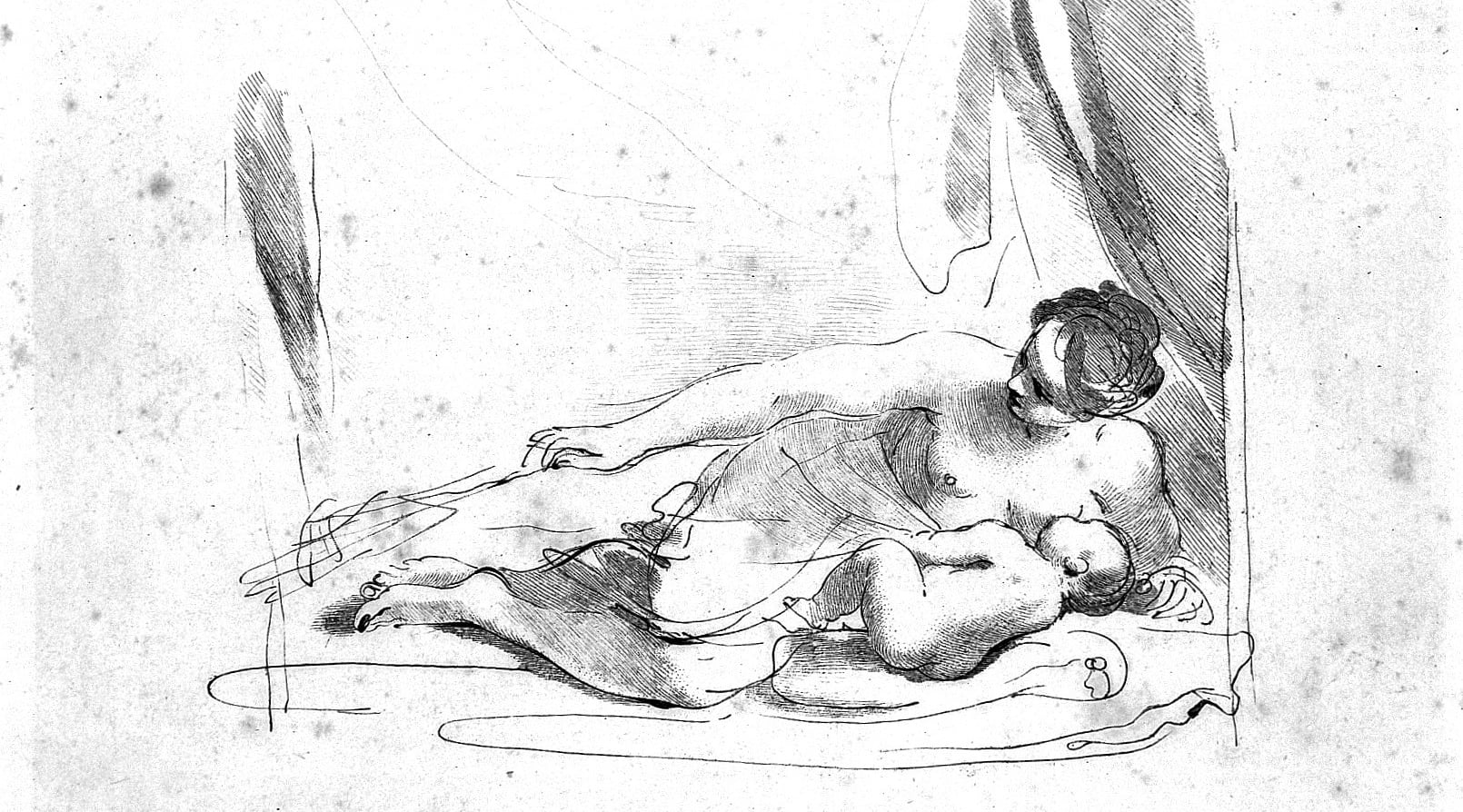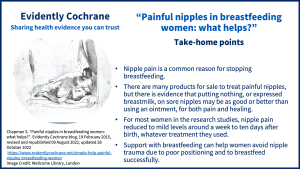In a blog for breastfeeding women affected by painful nipples, and people supporting them, Sarah Chapman looks at the evidence behind various treatmentSomething done with the aim of improving health or relieving suffering. For example, medicines, surgery, psychological and physical therapies, diet and exercise changes. options and the benefits of support.
Page originally published: 19 February 2015. Revised and republished 09 August 2022, to include guidance from The National Institute for Health and Care Excellence (NICE) and take-home points. Updated 28 October 2022 to include new evidence on support for breastfeeding mums with healthy term babies.
Take-home points
Many breastfeeding women experience painful nipples, and this is a common reason for stopping. That’s a source of concern and sadness for some mums as it can be a lovely, as well as beneficial, experience and leading authorities such as the World Health Organization recommend that babies should be breastfed for the first six months with no other food or drink given.
If you, or a woman you’re supporting, is experiencing nipple pain from feeding then you’re probably wondering what’s the best thing to do. We tend to do several things when making choices about our health – we seek advice from others, including friends and family, health professionals and online communities; we might ‘Google’ it; and we look at the shelves in the local chemist to see what products promise.
Over-the-counter treatments for painful nipples – are they worth it?
There’s nothing like a common problem to spawn a whole industry of products offering solutions. If you are a breastfeeding woman who’s feeling sore, should you part with your money for glycerin gel dressings, ointments, or breast shells with lanolin? How do you know if you should trust the claims?
A Cochrane ReviewCochrane Reviews are systematic reviews. In systematic reviews we search for and summarize studies that answer a specific research question (e.g. is paracetamol effective and safe for treating back pain?). The studies are identified, assessed, and summarized by using a systematic and predefined approach. They inform recommendations for healthcare and research. Interventions for treating painful nipples among breastfeeding women (published December 2014) brought together the best available research evidence on treatments for painful nipples in breastfeeding women. The four studies looked at five things to put on the nipples: glycerine pads, lanolin breast shells, lanolin alone, expressed breast milk, and an all-purpose nipple ointment. All the women were taught about how to position the baby at the breast, as part of routine care.
They found that:
- Applying nothing, or expressed breast milk, may be as good or better than applying an ointment, such as lanolin, for both nipple pain and healing.
- For most women, nipple pain reduced to mild levels around seven to ten days after giving birth, whatever treatment they used.
It can be hard to do nothing, when doing ‘something’ can make us feel more in control, but sometimes it may be the best thing of all.
Sometimes we need to stop doing something. The National Institute for Health and Care Excellence (NICE) says women with nipple damage can be advised “on stopping the use of nipple shields or breast shells, if appropriate, as these may contribute to incorrect positioning and attachment.” Also that applying expressed breast milk should be considered if the nipple is cracked.
Support for breastfeeding mums
Poor latching or positioning can cause nipple trauma, so it’s important that new mums are helped to get going with breastfeeding from the start. The Cochrane Review Interventions for promoting the initiation of breastfeeding (published November 2016) found that information and support from health professionals and/or peer supporters may increase the number of women who start breastfeeding their babies.
Another Cochrane Review Support for healthy breastfeeding mothers with healthy term babies (updated October 2022) found that “when ‘breastfeeding only’ support is offered to women, the duration and in particular, the exclusivity of breastfeeding is likely to be increased”. The evidence is less certain for breastfeeding support that is delivered as part of a wider interventionA treatment, procedure or programme of health care that has the potential to change the course of events of a healthcare condition. Examples include a drug, surgery, exercise or counselling. where additional services, such as well baby clinics and vaccination, are also provided.
The review authors found that breastfeeding support may be more helpful if given on four to eight planned visits. The person giving the support (professional or non‐professional) and how it’s given (face‐to‐face, phone, digital technologies or combinations) does not appear to make a difference.
More information and support
You might like these Evidently Cochrane blogs:
- New baby: fads, fashions and evidence for new parents.
- Breastfeeding: a round-up of Cochrane evidence.
The NICE page on Breastfeeding problems suggests the following sources:
- The National Childbirth Trust which runs a telephone helpline including breastfeeding support (0300 330 0700), and provides antenatal courses and written information on breastfeeding issues and infant feeding.
- The Breastfeeding Network which runs the national breastfeeding helpline (0300 100 0212) and provides written information on breastfeeding issues.
- The Association of Breastfeeding Mothers which is a partner in the national breastfeeding helpline (0300 100 0212) and provides written information on breastfeeding issues.
- The La Leche League GB which runs a telephone helpline (0345 120 2918), provides online help, runs local meetings, and provides written information on breastfeeding issues.
- The NHS A-Z leaflets Breastfeeding: the first few days, Breast feeding, Is my baby getting enough milk, Breast pain and breastfeeding, Common breastfeeding problems, Sore or cracked nipples when breastfeeding, and Breastfeeding and thrush.
You can join in the conversation on Twitter with @SarahChapman30 @CochraneUK or leave a comment on the blog.
Please note, we cannot give specific medical advice and do not publish comments that link to individual pages requesting donations or to commercial sites, or appear to endorse commercial products. We welcome diverse views and encourage discussion but we ask that comments are respectful and reserve the right to not publish any we consider offensive. Cochrane UK does not fact check – or endorse – readers’ comments, including any treatments mentioned.
Sarah Chapman has nothing to disclose.




This is interesting, only shows that breastfeeding aids has then evolved at lot. This should make breastfeeding a bit more tolerable than it used to be when breast shells or nipple balms are not yet around. Latch on seems to be the best advice even before.
I’d like to share a tip to address sore nipples (that lasted far longer for me than the 10 days mentioned here, by the way) that finally worked like a charm after my first baby was born. The La Leche League peer counselor I called suggested that my problem might be mostly positional, and she was so right.
Here’s what she advised: prop lots of pillows on your lap, and pretend you have an imaginary belly button directly between your breasts. Position the baby on his/her side so that the baby’s real belly button is “attached” to your imaginary belly button (this will feel and look like the baby is propped way too high, but trust me – this works!) To nurse, baby merely turns the head slightly at a comfy height that eliminates any pulling/pressure on the sore nipple.
The relief was almost instantaneous! Thank you, 38 years later, La Leche League!!
Could you tell me who the artist is who drew the sketch you used to go with the article please?
Thanks, Jenny Richardson.
BfN Breastfeeding Supporter and Tutor. (And artist.)
Hi, Lovely isn’t it? It’s freely available from the wonderful collection at wellcomeimages.org. Here are the details: L0010814 A woman lying down breast-feeding her baby. Etching by F. Bartolozzi after G. Guercino.
Credit: Wellcome Library, London. Wellcome Images
images@wellcome.ac.uk
http://wellcomeimages.org